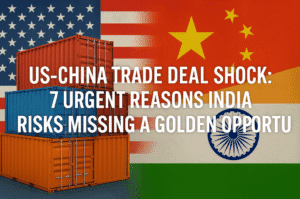US-China Trade Deal Shock: 7 Urgent Reasons India Risks Missing a Golden Opportunity
A potential US-China trade deal could recalibrate global supply chains, reviving China’s export dominance due to its unmatched manufacturing efficiency, while complicating India’s recent gains as a tariff-war beneficiary. Though India has seen fleeting opportunities in sectors like chemicals and textiles, structural gaps—such as its lag in non-leather footwear production and reliance on outdated infrastructure—limit its ability to fully replace China. Meanwhile, Vietnam and Bangladesh have leveraged Chinese expertise and relaxed policies to emerge as competitive alternatives, underscoring the importance of technical collaboration.
While sustained U.S. tariffs might benefit India, experts warn that any thaw in US-China tensions could swiftly shift orders back to Beijing, eroding India’s short-term advantages. Geopolitical distrust between Washington and Beijing, rooted in technology rivalry and security concerns, suggests decoupling will persist, creating openings for nations agile enough to adapt. For India, converting this moment into long-term growth demands urgent reforms in sectoral competitiveness, foreign partnerships, and trade diplomacy. Without addressing inefficiencies, India risks missing its window to become a trusted alternative in a fractured global economy.

US-China Trade Deal Shock: 7 Urgent Reasons India Risks Missing a Golden Opportunity
The prospect of a US-China trade deal looms as a double-edged sword for the global economy, with India caught in the crosscurrents of shifting supply chains and geopolitical maneuvering. While a potential agreement could stabilize two economic giants, its implications reveal deeper vulnerabilities and opportunities for emerging players like India. Here’s a nuanced breakdown of what’s at stake:
Global Supply Chains: A Reshuffled Deck
A US-China trade détente might revive China’s export dominance, thanks to its entrenched manufacturing prowess. However, the scars of recent tariffs have already accelerated a global supply chain rethink. Nations like Vietnam and Bangladesh have emerged as secondary hubs, often leveraging Chinese expertise to boost their own production capacities. Vietnam’s rise as Nike’s top supplier and Bangladesh’s textile boom underscore how smaller economies can capitalize on geopolitical fractures—provided they offer logistical ease and openness to foreign collaboration.
For advanced economies, reduced tariffs could lower inflation pressures by restoring cost-efficient Chinese imports. Yet, the U.S. remains wary of over-reliance on Beijing, with bipartisan consensus viewing China as a strategic rival. This tension ensures that even a deal won’t fully reverse the decoupling trend, leaving room for alternatives like India to step in—albeit cautiously.
India’s Moment: Promise vs. Reality
India’s recent export gains hinge on U.S. buyers seeking alternatives to Chinese goods. Sectors like chemicals, textiles, and engineering have seen spikes in inquiries. Yet, structural gaps threaten to cap these gains:
- Sectoral Limitations: India’s footwear industry, for instance, remains skewed toward leather products, while U.S. demand leans heavily on non-leather varieties—a segment where China (and increasingly Vietnam) dominates.
- Capacity Constraints: Unlike Vietnam, which rapidly integrated Chinese technical know-how and machinery, India’s regulatory hurdles and slower adoption of automation hinder scalability.
- Competition from Neighbors: Bangladesh’s relaxed policies for Chinese technicians and Vietnam’s agile manufacturing ecosystems highlight India’s need for reforms to attract foreign expertise and investment.
The Tariff Lifeline: A Temporary Reprieve?
Experts like Richard Baldwin argue that sustained U.S. tariffs on China could be a boon for India, but only if it addresses internal bottlenecks. The deferred reciprocal tariffs excluded high-potential sectors like pharmaceuticals and electronics—areas where India could expand with targeted policy support. However, the window is narrowing. A US-China deal, even a limited one, might see Chinese exporters reclaim market share swiftly, aided by their advanced infrastructure and economies of scale.
Geopolitical Wildcards
The U.S.-China rivalry transcends trade, rooted in technology competition and national security fears. Washington’s recent restrictions on semiconductors and green tech subsidies reflect a strategy to curb Beijing’s ascendancy. For India, this offers a strategic opening: aligning with Western initiatives like the Indo-Pacific Economic Framework (IPEF) or the Quad could secure its role in alternative supply chains. However, India’s inconsistent trade negotiation track record—seen in stalled deals with the EU and Australia—raises questions about its ability to seize this moment.
The Road Ahead for India
To avoid squandering this geopolitical windfall, India must:
- Boost Sectoral Competitiveness: Invest in R&D for non-leather footwear, electronics, and pharmaceuticals while streamlining labor and land reforms.
- Attract Partnerships: Facilitate joint ventures with Chinese or Southeast Asian firms to bridge technical gaps, as Vietnam has done.
- Leverage Diplomacy: Fast-track trade pacts with the U.S. and EU, emphasizing India’s democratic alignment and market potential.
Conclusion: A Fragile Equilibrium
A US-China trade deal may temporarily ease global economic tensions but won’t erase the strategic distrust driving their rivalry. For India, the challenge lies in converting short-term gains into long-term structural shifts. While Chinese recovery could dim India’s export spotlight, the broader decoupling trend offers a runway for growth—if India can address its inefficiencies and position itself as a reliable, scalable alternative. The world isn’t just watching US-China talks; it’s recalibrating for a multipolar trade era where agility and strategy will define winners.
You must be logged in to post a comment.